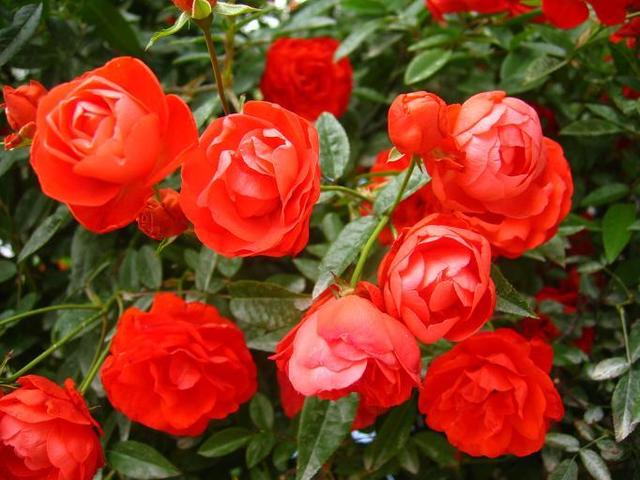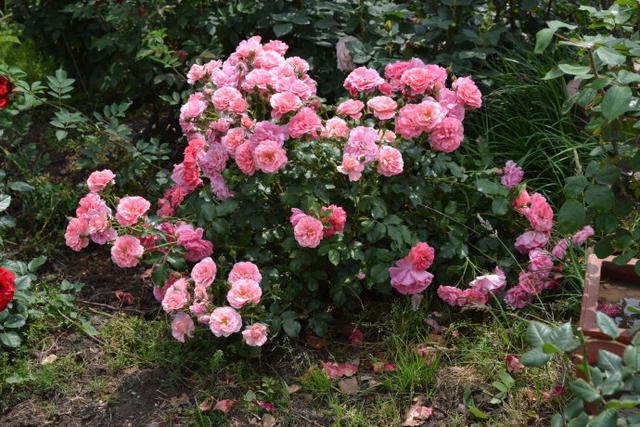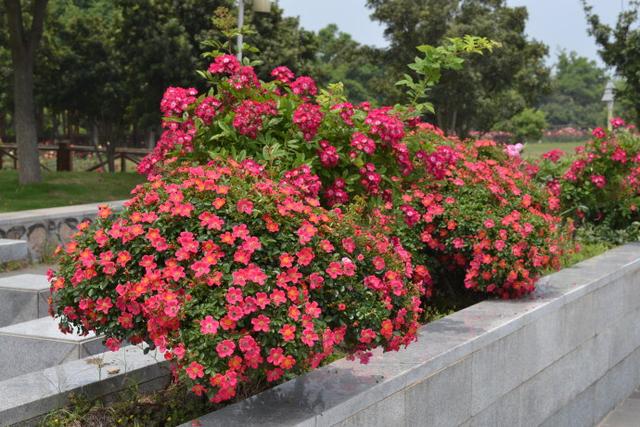Culture methods and common diseases and insect pests of ground cover rose
[introduction] ground cover rose actually refers to the rattan rose, because it is mainly creeping spread growth, is a better ground cover plant, so it is called ground cover rose. The ground used by rose in landscape design has its unique advantages, such as creeping expansion, large coverage, high temperature and drought resistance, strong disease resistance and so on. And there are many kinds of ground cover rose, most of which are very easy to feed.
Although the ground rose belongs to the plant with strong resistance to diseases and insect pests, it does not mean that it will not be infected with diseases and insect pests. Of course, this does not prevent it from being widely used in garden applications. Let's take a look at it.

Eight advantages of landscape application of ground cover rose
1. It is creeping and expanding, with a height of not more than 20 cm. Each plant sprouts more than 50 branches a year, the branches touch the ground and take root, and each branch blossoms 50-100 at a time.
two。 The root system is well developed and the deepest root is more than 2 meters.
3. The coverage is large, with a single plant covering an area of more than 1 square meter.
4. The flowering is strong in groups, and the flowering period of the four seasons is continuous.
5. Resistant to drought, can grow in areas with annual rainfall of 150-200 mm, and can grow in areas with barren land, sloping land, shade and irrigation difficulties.
6. It can grow normally at high temperature, high humidity-30 ℃ low temperature and 42 ℃ high temperature.
7. Extensive management, strong disease resistance, no application, no pruning, reducing a lot of management costs.
8. The effect of arranging color blocks and road belts is remarkable, which can not only beautify the environment, but also reduce noise, heat absorption and other advantages, so it is a good product for water conservation and soil erosion.

The classification of ground cover rose
1. There are many classification methods of ground cover rose, which can be classified into erect type and climbing type according to its growth characteristics. Upright type: stout branches, can grow upright without relying on flower racks and other supports, low height, generally between 1.5 meters and 2.5 meters, can be used in flower hedges, flower barriers, flower walls and so on. Climbing type: with slender vines, height from 2.5 meters to 10 meters, need to be attached to flower racks, columns climbing up, mainly used for flower arches, flower galleries, styles and so on.
two。 According to their flowering habits, they can be divided into three categories: multi-season flowers, second-season flowers and first-season flowers. Multi-season flowers can blossom repeatedly in the growing season and continue to blossom until winter dormancy. Some vines not only bloom continuously, but also have a large number of flowers, which is the most suitable variety in landscaping, and the beautification effect is excellent. Such as Dortmund and so on. After the second season flowers bloom from May to June, they usually bloom a little or not in early summer and autumn, and then blossom again before and after the Mid-Autumn Festival, but the amount of flowers is far less than that from May to June. One-season flowers usually stop blooming after blooming from May to June, or only a very small number of flowers will bloom in the future, and will not bloom again until next year. These varieties often have strong drought resistance, disease resistance, cold resistance, and strong climbing.

Common diseases of ground cover rose and their control
1. Root cancer: root cancer is a major disease for producers in countries without cold winters and is common in Asia, Africa, Australia and India. It is said that root cancer is caused by rootstocks, but it may also exist in the soil and attach to the host when the seedlings are planted. Chemical control and the use of resistant rootstocks can only play a role in control to a certain extent. The only way to prevent root cancer infection is to use soilless cultivation or to buy root rootstocks from frosty areas. Daily control is to disinfect the seedbed soil, plant resistant rootstocks or carry out soilless cultivation before planting.
two。 The pathogen of Botrytis cinerea is Botrytis cinerea. After the bud was infected by Botrytis cinerea, the bud turned brown and rotten. When the flowers are in bloom, individual petals become brown and wrinkled. The disease is prone to occur on old flowers that have not been picked, especially in wet conditions and rainy seasons. When the disease is serious, the opening of the flower organ is hindered. In winter, there is Botrytis cinerea on the withered stem of rose. For prevention and control, diseased flowers should be removed in time, withered presbyopia should be removed, and concentrated burning should be done. Spraying chemical drugs at the initial stage of plant growth, such as 1000 times solution of 70% Fumei and 1000 times solution of 50% benzoate, can be effectively prevented.

Generally speaking, as long as the breeding and nursing is proper, the diseases and insect pests of the rose are relatively rare, so in irrigation, fertilization, or other breeding links, we should be careful even if we are not careful. Only in this way can we ensure its healthy growth.
Follow WeChat account: xiaobency shares around 9: 00 every day, and ten thousand people listen to it.
- Prev

Culture method of indoor plant white palm
Usually in the flower-and-bird market in the south, we can often see the white palm, whose Chinese name is white crane taro, which is more suitable for potted plants indoors.
- Next

Culture methods and matters needing attention of Hongcai Pavilion
Red Pavilion is usually very strange to everyone, including very little information about it on the Internet, but anyone who has seen it knows it.
Related
- On the eggshell is a badge full of pride. British Poultry Egg Market and Consumer observation
- British study: 72% of Britons are willing to buy native eggs raised by insects
- Guidelines for friendly egg production revised the increase of space in chicken sheds can not be forced to change feathers and lay eggs.
- Risk of delay in customs clearance Australia suspends lobster exports to China
- Pig semen-the Vector of virus Transmission (4)
- Pig semen-the Vector of virus Transmission (3)
- Five common causes of difficult control of classical swine fever in clinic and their countermeasures
- Foot-and-mouth disease is the most effective way to prevent it!
- PED is the number one killer of piglets and has to be guarded against in autumn and winter.
- What is "yellow fat pig"? Have you ever heard the pig collector talk about "yellow fat pig"?

